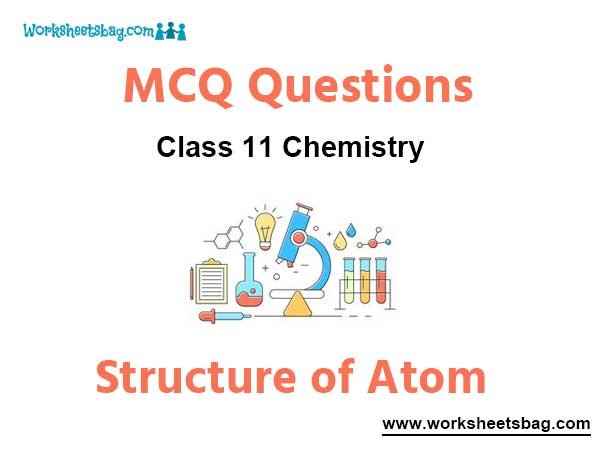Please refer to Structure of Atom MCQ Questions Class 11 Chemistry below. These MCQ questions for Class 11 Chemistry with answers have been designed as per the latest NCERT, CBSE books, and syllabus issued for the current academic year. These objective questions for Structure of Atom will help you to prepare for the exams and get more marks.
Structure of Atom MCQ Questions Class 11 Chemistry
Please see solved MCQ Questions for Structure of Atom in Class 11 Chemistry. All questions and answers have been prepared by expert faculty of standard 11 based on the latest examination guidelines.
MCQ Questions Class 11 Chemistry Structure of Atom
Question. Increasing order (lowest first) for the values of elm for electron (e), proton (p ), neutron (n) and a-particles is
(a) e,p,n,a
(c) n,p, e, a
(b) n, a,p, e
(d) n,p, a, e
Answer
B
Question. The electronic configuration of a dipositive ion M 2+ is 2, 8, 14 and its mass number is 56. The number of neutrons present is
(a) 32
(b) 42
(c) 30
(d) 34
Answer
C
Question. An isobar of 20Ca40 is
(a) 18Ar40
(b) 20Ar42
(c) 20Ar38
(d) 18Ar38
Answer
A
Question. The lightest particle is
(a) a -particle
(c) proton
(b) positron
(d) neutron
Answer
B
Question. How many neutrons are present in tritium nucleus?
(a) 2
(b) 3
(c) 1
(d) 0
Answer
A
Question. Which one of the following has unit positive charge and 1 u mass?
(a) Electron
(c) Proton
(b) Neutron
(d) None of these
Answer
C
Question. If the radius ofH is 0.54 A, then what will be the radius of 3Li2+?
(a) 0.17 Å
(b) 0.36 Å
(c) 0.53 Å
(d) 1.59 Å
Answer
A
Question. A gas absorbs photon of 355 nm and emits at two wavelengths. If one of the emission is at 680 nm, the other is at
(a) 1035 nm
(c) 743 nm
(b) 325 nm
(d) 518 bm
Answer
C
Question. The frequency of light emitted for the transition n = 4 to n = 2 of He+ is equal to the transition in H atom co1Tesponding to which of the following?
(a) n = 3 to n = l
(b) n = 2 to n = l
(c) n = 3 to n = 2
(d) n = 4 to n= 3
Answer
B
Question. Zeeman effect refers to the
(a) splitting up of the lines in an emission spectrum in the presence of an external electrostatic field
(b) random scattering of light by colloidal particles
(c) splitting up of the lines in an emission spectrum in a magnetic field
(d) emission of electrons from metals when light falls upon them
Answer
C
Question. The energy of hydrogen atom in its ground state is – 13.6eV. The energy of the level corresponding to the quantum number n = 5 is
(a)-5.4eV
(b) – 0.54eV
(c) – 2.72eV
(d) – 0.85eV
Answer
B
Question. If the energy difference between the ground state of an atom and its excited state is 4.4 x l0-4 J, the wavelength of photon required to produce the transition
(a) 2.26 x 10-12 m
(b) l.13 x 10-12 m
(c) 4.52 x 10-12 m
(d) 4.52 x 10-12 m
Answer
D
Question. The ionisation enthalpy of hydrogen atom is I. 312 x 106 J mol-1 • The energy required to excite the electron in the atom from n1 = 1 to n2 = 2 is
(a) 8.51 x 105 J rnol-1
(b) 6.56 X 105 J rnol-1
(c) 7.56 x 105 J rnol-1
(d) 9.84 x 105 J rnol-1
Answer
D
Question. An electronic transition in hydrogen atom results in the formation of H0 line of hydrogen in Lyman series, the energies associated with the electron in each of the orbits involved in the transition (in kcal rnol-1) are
(a) – 313.6, – 34.84
(c) – 78.4, – 34.84
(b) – 313.6, – 78.4
(d) – 78.4, – 19.6
Answer
B
Question. Deflection back of a few particles on hitting thin foil of gold shows that
(a) nucleus is heavy
(b) nucleus is small
(c) Both (a) and (b)
(d) lectrons create hinderance in the movement of a-particles
Answer
C
Question. Which of the following is Heisenberg uncertainty principle ?
(a) Δx · Δp ≥ h/4n
(b) Δx · Δp = h/4n
(c) Δx · Δp ≤ h/4n
(d) Δx · Δp < h/4n
Answer
A
Question. The uncertainty in the momentwn of an electron is 1.0 x 10-5 kg ms-1 . The uncertainty in its position will be
(a) 1.50 x 10-28 m
(b) 1.05 x 10-26 m
(c) 5.27 x 10-3o m
(d) 5.25 x 10-28 m
Answer
C
Question. The orbital angular momentum of an electron in 2s orbital is
(a) + 1/2 . h/2n
(b) h/2n
(c) h/2n
(d) √2 h/2n
Answer
B
Question. The orbital angular momentum of an electron in 3s-orbital is
(a) 1/2 . h/2n
(b) h/2n
(c) 1/3 . h/2n
(d) zero
Answer
D
Question. Which of the following sets of quantum numbers is correct for an electron in 4 f-orbital ?
(a) n = 4, I = 3, m = + 4, s = + 1/2
(b)n = 4,l = 4,m=- 4,s= – 1/2
(c) n= 4,l=3,m=+ l,s= + 1/2
(d) n= 3,l = 2, m = – 2, s = + 1/2
Answer
C
Question. The velocities of two particles A and B are 0.05 and 0.02ms -1 respectively. The mass of Bis five times the mass of A. The ratio of their de-Broglie’s wavelength is
(a) 2 : 1
(b) 1: 4
(c) 1 : 1
(d) 4: 1
Answer
A
Question. Which of the following expressions gives the de-Broglie relationship ?
(a) p = h/mv
(b) λ = h/mv
(c) λ = h/mp
(d) λm = v/p
Answer
B
Question. Uncertainty in position of a particle of 25 g in space is 10-5m. Hence, uncertainty in velocity (ms-1 ) is (Planck’s constant h = 6.6 x 10-34 Js)
(a) 2.lx 10-28
(c) 0.5 X 10-34
(b) 2.1 X 10-34
(d) 5.0x 10-24
Answer
A
Question. In an atom, an electron is moving with a speed of 600 mis with an accuracy of 0.005%. Certainity with which the position of the electron can be located is (h = 6. 6 x 10-34 kg m2 s-1 , mass of electron, em = 9.1 x 10-31 kg)
(a) l.52x 10-4 m
(b) 5.I0x 10-3 m
(c) l.92x 10-3 m
(d) 3.84 x 10-3 m
Answer
C
Question. Calculate the wavelength (in nanometer) associated with a proton moving at 1.0 x 103 ms-1 (Mass of proton = 1.67 x 10-27 kg and h = 6. 63 x 10-34 Js)
(a) 0.032 nm
(b) 0.40 nm
(c) 2.5 nm
(d) 14.0 nm
Answer
B
Question. A body of mass x kg is moving with a velocity ofl 00 ms-1 Its de-Broglie wavelength is 6. 62 x l0-35 m. Hence, x is (h = 6.62 X 10-34 Js)
(a) 0.1kg
(b) 0.25 kg
(c) 0.15 kg
(d) 0.2 kg
Answer
A
Question. An electron with values 4, 3, – 2 and+ 1/2 for the set of four quantum numbers n, I, m1 and ms, respectively, belongs to
(a) 4s orbital
(b) 4 p orbital
(c) 4d orbital
(d) 4 f orbital
Answer
D
Question. The total number of orbitals possible for p1incipal quantum number n is
(a) n
(b) n2
(c) 2n
(d) 2n2
Answer
B
Question. The set of quantum numbers for the outermost electron for copper in its ground state is
(a) 4,1, l, + 1/2
(b) 3,2,2, + 1/2
(c) 4,0,0, + 1/2
(d) 4,2,2, + 1/2
Answer
C
Question. If the quantum nwnbers for the 5th electron in carbon atoms are 2, 1, 1, + 1/2, then for the 6th electron, these values would be
(a) 2, 1, 0, – 1/2
(b) 2, 0,1, + 1/2
(c) 2,l,1, – 1/2
(d) 2,l,-l, + 1/2
Answer
D
Question. Which of the following sets of quantwn numbers is correct ?
(a) n = 5, I= 4, m = 0, s = + 1/ 2
(b) n = 3, I = 3, m = + 3, s = + 1 / 2
(c) n = 6, I = 0, m = + l, s = – JI 2
(d) n = 4, I = 2, m = + 2, s = 0
Answer
A
Question. The number of electrons accommodated in an orbit with principal quantum number 2, is
(a) 2
(b) 6
(c) 10
(d) 8
Answer
D
Question. Which of the following is not possible ?
(a) n = 2, l = 1, m = 0
(b) n = 2, I = 0, m = -1
(c) n = 3, I = 0, m = 0
(d) n = 3, I = 1, m = – l
Answer
B
Question. The orbital angular momentum of an electron in a d-orbital is
(a) √6h/2n
(b) √2h/2n
(c) h/2n
(d) 2h/2n
Answer
A
Question. Time period of a wave is 5 x 10–3 s, what is the frequency ?
(a) 5 x 10–3 s–1
(b) 2 x 10–2 s–1
(c) 23 x 10–3 s–1
(d) 5 x 10–2 s–1
Answer
B
Question. An electron from one Bohr stationary orbit can go to next higher orbit
(a) by emission of electromagnetic radiation
(b) by absorption of any electromagnetic radiation
(c) by absorption of electromagnetic radiation of particular frequency
(d) without emission or absorption of electromagnetic radiation
Answer
C
Question. Which of the following species have the same number of electrons in its outennost as well as penultimate shell
(a) CI–
(b) 02 –
(c) Na+
(d) Mg 2+
Answer
A
Question. Which one of the following has a magnetic moment of 1.75 BM?
(a) y 3+
(c) Fe3+
(b) Cr3+
(d) Ti3+
Answer
D
Question. Which of the following laws will represent the pairing of electron in a subshell after each orbital is filled with one electron?
(a) Pauli’s exclusion principle
(b) Hund’s rule
(c) Heisenberg’s uncertainty principle
(d) Hess law
Answer
B
Question. The correct set of four quantwn mm1ber for the valence electrons ofrubidiwn atom (Z = 37) is
(a) 5,0,0, + 1/2
(b) 5,1,0, + 1/2
(c) 5,l,1, + 1/2
(d) 5,0,1 + 1/2
Answer
A
Question. Which of the following is correct for nwnber of electrons, nwnber of orbitals and type of orbitals respectively in n-orbit ?
(a) 4, 4 and 8
(c) 32, 16 and 4
(b) 4, 8 and 16
(d) 4, 16 and 32
Answer
C
Question. The nodes present in 3p–orbitals are
(a) one spherical, one planar
(b) two spherical
(c) two planar
(d) one planar
Answer
A
Question. The energy ratio of a photon of wavelength 3000 Å and 6000 Å is
(a) 1:1
(b) 2:1
(c) 1:2
(d) 1:4
Answer
B
Question. Which of the following sets of quantwn nwnbers could represent the last electron added to complete the electron configuration for a ground state atom of Br (Z = 35) according to the Autbau principle n : l; m1 ; ms
(a) 4;0;0;-l/2
(b) 4; l;l;- 1/ 2
(c) 3;1;1; – l/2
(d) 4; 1;2;+1/ 2
Answer
A
Question. The statement that is not correct is
(a) Angular quantum number signifies the shape of the orbital
(b) Energies of stationary states in hydrogen like atoms is inversely propo1tional to the square of the principal quantum nun1ber
(c) Total number ofnodes for 3s-orbital is three
(d) The radius of the first orbit of He+ is half that oftbe first orbit hydrogen atom
Answer
D
Question. According to Bohr’s theory, the angular momentum of an electron in 5th orbit is
(a) 25h/π
(b) 1.0h/π
(c) 10h/π
(d) 2.5h/π
Answer
D
Question. The number of waves in an orbit are
(a) n2
(b) n
(c) n – 1
(d) n – 2
Answer
B
Question. Energy of one mole of photons of radiation whose frequency is 5 X 1014 Hz is
(a) 199.51 kJ mol-1
(b) 189.51 kJ mol-1
(c) 198.51 kJ mol-1
(d) 188.51 kJ mol-1
Answer
A
Question. Which of the following does not represent the mathematical expression for the Heisenberg uncertainty principle?
(a) Δx . Δp ≥ h/ (4π)
(b) Δx . Δv ≥ h/ (4πm)
(c) Δx . Δf ≥ h/ (4π)
(d) Δx . Δx≥ h/ (4π)
Answer
D


